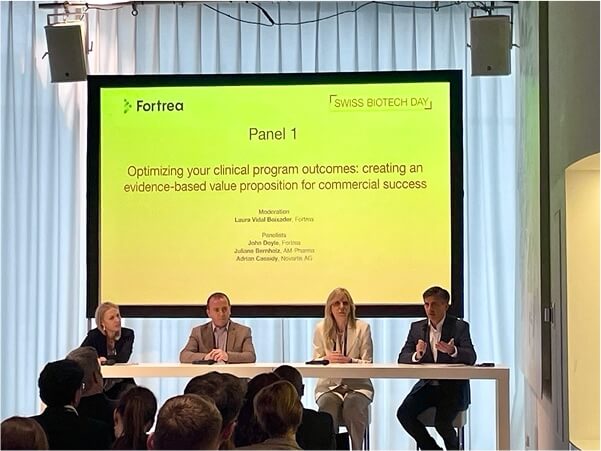Bridging Innovation and Impact: Why Evidence Generation is the New Currency in Biotech
OncoInsights by Laura Vidal, MD
Vice President and Therapeutic Strategy Lead for Oncology
During Swiss Biotech Day 2025, held on May 5–6 in Basel, Fortrea hosted a panel session titled Medical Evidence Generation for Biotechnology Value Optimization” bringing experts from across clinical development, market access, and health economics to explore how medical evidence—both clinical and real-world—can be strategically leveraged.
In an increasingly complex biopharmaceutical landscape—shaped by escalating R&D costs, constrained capital, and intensified scrutiny from payers and regulators—biotech companies must demonstrate product value early and convincingly. It’s no longer enough to show that a new therapy works; companies must prove that it matters to patients, clinicians, and health systems. Value demonstration has become the essential link between scientific promise and real-world impact.

To achieve this, evidence generation must be reframed as a continuous, strategic process—beginning early in clinical development and extending through commercialization. This includes integrating clinical efficacy, health economics, and patient-reported outcomes to construct a multidimensional value proposition. As several experts noted, early-stage programs must anticipate the information needs of both payers and patients, even before pivotal trial data are available. Embedding patient-centered outcomes into trial design from the outset not only improves relevance but also supports shared decision-making and long-term engagement.
Fortunately, advancements in digital health technologies—including sensors, wearables, and remote monitoring tools—offer new avenues for collecting real-time, patient-specific data. When validated, such tools can enhance endpoint sensitivity and expand the understanding of therapeutic benefit in everyday settings. While Health Technology Assessment (HTA) agencies have historically been cautious, they are increasingly receptive to digital data, particularly when it augments traditional clinical endpoints with patient-centric insights.
Similarly, real-world evidence (RWE) has emerged as a vital complement to randomized controlled trials, offering contextual data on safety, effectiveness, and health system impact. When combined with economic modeling and long-term outcomes data, RWE can significantly strengthen the case for reimbursement and broader access. However, these efforts are most effective when clinical and access strategies are integrated early in the development process. Trial designs must be adaptive, comparative, and outcome-focused to meet evolving payer expectations, especially in areas such as cost-effectiveness, quality of life, and durable clinical response.
Ultimately, collaboration across industry, regulators, and payers is key. As trends like personalized medicine, value-based pricing, and digital integration reshape the landscape, biotech companies that invest early in relevant, stakeholder-driven evidence will be better positioned for long-term success and broader patient reach. The future of access isn’t just about bigger trials but better, smarter evidence that meets the needs of all stakeholders—patients, clinicians, payers, and investors alike.